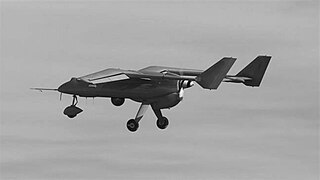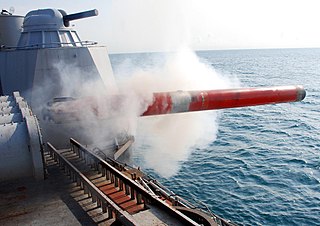
A modern torpedo is an underwater ranged weapon launched above or below the water surface, self-propelled towards a target, and with an explosive warhead designed to detonate either on contact with or in proximity to the target. Historically, such a device was called an automotive, automobile, locomotive, or fish torpedo; colloquially a fish. The term torpedo originally applied to a variety of devices, most of which would today be called mines. From about 1900, torpedo has been used strictly to designate a self-propelled underwater explosive device.

PNS/M Hangor (S-131) was a Daphné-class diesel-electric submarine that served in the Pakistan Navy from 1969 until its decommissioning in 2006. It is the first submarine to sink a ship after World War II.

An anti-submarine weapon (ASW) is any one of a number of devices that are intended to act against a submarine and its crew, to destroy (sink) the vessel or reduce its capability as a weapon of war. In its simplest sense, an anti-submarine weapon is usually a projectile, missile or bomb that is optimized to destroy submarines.

The HJ-8 or Hongjian-8 is a second generation tube-launched, optically tracked, wire-guided anti-tank missile system which was originally deployed by the People's Liberation Army since the late 1980s.

The Mark 54 lightweight torpedo is a standard 12.75-inch (324 mm) anti-submarine warfare (ASW) torpedo used by the United States Navy.

A missile boat or missile cutter is a small, fast warship armed with anti-ship missiles. Being smaller than other warships such as destroyers and frigates, missile boats are popular with nations interested in forming a navy at lower cost. They are similar in concept to the torpedo boats of World War II; in fact, the first missile boats were modified torpedo boats with the torpedo tubes replaced by missile tubes.

An acoustic torpedo is a torpedo that aims itself by listening for characteristic sounds of its target or by searching for it using sonar. Acoustic torpedoes are usually designed for medium-range use, and often fired from a submarine.

Anti-submarine warfare is a branch of underwater warfare that uses surface warships, aircraft, submarines, or other platforms, to find, track, and deter, damage, or destroy enemy submarines. Such operations are typically carried out to protect friendly shipping and coastal facilities from submarine attacks and to overcome blockades.

The history of unmanned combat aerial vehicles (UCAVs) is closely tied to the general history of unmanned aerial vehicles (UAVs). While the technology dates back at least as far as the 1940s, common usage in live operations came in the 2000s. UCAVs have now become an important part of modern warfare, including in the Syrian civil war, the 2020 Nagorno-Karabakh war and during the 2022 Russian invasion of Ukraine.

Naval tactics and doctrine is the collective name for methods of engaging and defeating an enemy ship or fleet in battle at sea during naval warfare, the naval equivalent of military tactics on land.

The National Engineering & Scientific Commission (NESCOM) is a Pakistani government-funded defence contractor that develops, designs and sells defense hardware, including missile and weapon systems. It was funded and formed by the Government of Pakistan to develop its domestic production of weapon system.

The Zulfiquar-class frigate, also known as F-22P or in English: Sword class, is a class of multi-mission guided missile frigates, in service with the Pakistan Navy. The class is based on an updated model of the Chinese design, the Type 053H3. The frigates were designed and built jointly in Hudong–Zhonghua Shipbuilding in China and the KS&EW Ltd. in Pakistan.

The Torpedo Advanced Light (TAL) Shyena is the first indigenous advanced lightweight anti-submarine torpedo of India, developed by the Naval Science and Technological Laboratory (NSTL) of the Defence Research and Development Organisation (DRDO) for the Indian Navy. The lightweight torpedo can be launched by ships, helicopters and previously the now retired Ilyushin Il-38, named after the divine hawk identified with Agni.

The Burraq is an unmanned combat aerial vehicle (UCAV) jointly developed and built by the National Engineering and Scientific Commission (NESCOM) and the Pakistan Air Force (PAF).
Drone warfare is a form of warfare using robots. Robot types include unmanned combat aerial vehicles (UCAV) or weaponized commercial unmanned aerial vehicles (UAV), unmanned surface vehicles, and ground based drones. The United States, the United Kingdom, Israel, China, South Korea, Iran, Iraq, Italy, France, India, Pakistan, Russia, Turkey, Ukraine, and Poland are known to have manufactured operational UCAVs as of 2019.

The Varunastra is an Indian advanced autonomous heavyweight anti-submarine torpedo, developed by the Naval Science and Technological Laboratory (NSTL) of the Defence Research and Development Organisation (DRDO) for the Indian Navy. It is named after a legendary weapon created by the Hindu god of the oceans, Varuna.
A loitering munition, also known as a suicide drone, kamikaze drone, or exploding drone, is a kind of aerial weapon with a built-in warhead that is typically designed to loiter around a target area until a target is located, then attack the target by crashing into it. Loitering munitions enable faster reaction times against hidden targets that emerge for short periods without placing high-value platforms near the target area and also allow more selective targeting as the attack can be changed mid-flight or aborted.
The Babur-class corvette, also known as the PN MILGEM class, is a class of four heavy corvettes under construction for the Pakistan Navy. This class is a subclass of the Turkish MILGEM project. The corvette class is heavier and larger than the Turkish Ada-class corvette and are also equipped with VLS.

SMART is a canister-based, long-range supersonic anti-submarine missile developed by the Defence Research and Development Organisation (DRDO) for the Indian Navy.
The Hangor-class submarines are a class of diesel–electric attack submarines currently being manufactured by a joint-partnership of the China Shipbuilding Industry Corporation (CSIC) and the Karachi Shipyard & Engineering Works (KSEW) for the Pakistan Navy (PN). Eponymously christened after the former-Daphné-class submarines that the PN operated between 1970 and 2006, the class is an export derivative of the Chinese-origin Type 039A/041 attack submarine, currently operated by the People's Liberation Army Navy (PLAN). First unveiled to the public in 2018, the future submarines are envisaged to undertake anti-access/area denial operations within Pakistan's exclusive economic zone, through the use of heavyweight torpedoes and anti-ship cruising missiles.















